Does your learning management technology have the features and capabilities favored by L&D leaders? Are you up to speed with the learning management trends that will define how learning tech evolves? Do you have the data at your fingertips to make a business case for your LMS?
You do now!
In 2023, Bridge sponsored an in-depth survey from HR.Research Institute on the subject of learning management technology. Drawing from the expert opinions of hundreds of L&D professionals, the report produced huge volumes of statistics about learning technology—from the top benefits of today’s tech to the weaknesses that come with it.
We’ve broken that data into bite-sized chunks and drawn out some of the most significant nuances. In the full “Future of Learning Technologies” report, key pieces of data are segmented into responses from learning leader organizations and learning laggards. Leaders are respondents who agree (or strongly agree) that the overall quality of their organizations’ learning is excellent, whereas laggards are respondents who disagreed, strongly disagreed, or felt neutral toward the statement that their overall learning quality is excellent.
So: ready to dive into 261 in-depth LMS statistics, learning tech insights, and the trends that underpin them? Let’s get started.
Does Learning Technology Play a Critical Role in Learning and Development?
There’s a near-consensus view among L&D professionals that learning tech is an essential part of L&D. This is less a learning management trend as it is a long-standing truth, but there’s no harm in reaffirming the essentials. Here’s what the responses show:
- 50% of L&D professionals strongly agree that learning technologies play a critical role in L&D at their organizations
- 33% of L&D professionals agree that learning technologies play a critical role in L&D at their organizations
- 10% of L&D professionals neither agree nor disagree that learning technologies play a critical role in L&D at their organizations
- Just 3% of L&D professionals disagree with the idea that learning technologies play a critical role in L&D at their organizations
- Just 5% of L&D professionals strongly disagree with the idea that learning technologies play a critical role in L&D at their organizations
MORE FACTS AND FIGURES | ‘10 Facts & Stats About Learning Retention You’ll Want to Remember’
How Does the Data Change When You Compare Learning Leaders to Learning Laggards?
While there’s general agreement that learning tech is critical, this isn’t a view shared by everyone.
Strikingly (but not surprisingly!) just over one-third of laggards feel that technology is a crucial element to their L&D efforts. Take a look:
- 64% of L&D professionals from learning leader organizations think technologies play a critical role in L&D
- Just 35% of L&D professionals from learning laggard organizations think technologies play a critical role in L&D
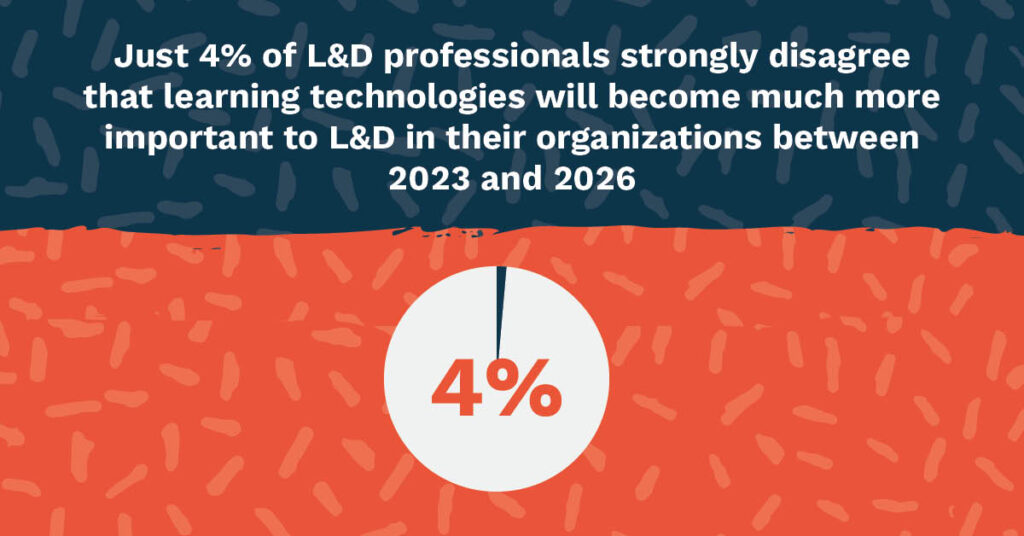
How Will Learning Technology’s Importance Change Over Time?
There’s very little chance that learning technology’s usefulness will lessen any time soon, and that’s a view broadly reflected in the attitudes of our respondents. Here’s what they had to say:
- 43% of L&D professionals strongly agree that learning technologies will become much more important to L&D in their organizations between 2023 and 2026
- 35% of L&D professionals agree that learning technologies will become much more important to L&D in their organizations between 2023 and 2026
- 15% of L&D professionals neither agree nor disagree that learning technologies will become much more important to L&D in their organizations between 2023 and 2026
- Just 3% of L&D professionals disagree that learning technologies will become much more important to L&D in their organizations between 2023 and 2026
- Just 4% of L&D professionals strongly disagree that learning technologies will become much more important to L&D in their organizations between 2023 and 2026
How Does the Data Change When You Compare Learning Leaders to Learning Laggards?
Again, it’s no surprise that respondents who self-identify as having excellent L&D records at their organizations are more likely to believe in the growing importance of learning tech. Here’s how the data plays out:
- 62% of L&D professionals from learning leader organizations believe learning technologies will play a critical role in the future
- Just 39% of L&D professionals from learning laggard organizations believe learning technologies will play a critical role in the future
Learning Technology Expenditure: How Much Are Organizations Spending on L&D Tech?
Learning technologies are an investment—which means technologies like LMSs need a business case backed by a budget. Here’s a breakdown of their L&D spend:
- 25% of organizations have an estimated budget of less than $500 per employee between 2023 and 2025
- 26% of organizations have an estimated budget of $501-$1,000 per employee between 2023 and 2025
- 9% of organizations have an estimated budget of $1,001-$5,000 per employee between 2023 and 2025
- 2% of organizations have an estimated budget of $5,001-$10,000 per employee between 2023 and 2025
- 11% of organizations have an estimated budget of over $10,000 per employee between 2023 and 2025
- 27% of organizations don’t have a set budget for learning technologies
MORE ABOUT LEARNING TECH SPEND | ‘Pitch (And Implement) Your Training Budget With These 4 Simple Steps’
The Factors That Drive Employee Learning
There might be broad agreement that learning tech is necessary and worth investing in—but what motivates those investments? Respondents were asked to name the four most important factors for driving learning in their organizations, and here are their selections:
- 62% of L&D professionals named employee career development among the top factors driving learning in their organizations
- 49% of L&D professionals named new skills development among the top factors driving learning in their organizations
- 47% of L&D professionals named increased employee engagement among the top factors driving learning in their organizations
- 40% of L&D professionals named regulatory compliance among the top factors driving learning in their organizations
- 36% of L&D professionals named employee retention among the top factors driving learning in their organizations
- 34% of L&D professionals named boosted job performance among the top factors driving learning in their organizations
- 28% of L&D professionals named skills maintenance among the top factors driving learning in their organizations
- 23% of L&D professionals named the facilitation of culture change among the top factors driving learning in their organizations
- 20% of L&D professionals identified return on investment as a top factor driving learning in their organizations
- 16% of L&D professionals named digital transformation among the top factors driving learning in their organizations
- 12% of L&D professionals named improved agility among the top factors driving learning in their organizations
- 9% of L&D professionals named improved competitive advantages among the top factors driving learning in their organizations

How Will LMSs and Learning Technologies Change Between 2023 and 2026?
The future holds a broad array of possibilities when it comes to learning tech—and while only a handful of L&D professionals predict a rise in metaverse-related technologies or virtual reality, there are plenty of anticipated changes that our respondents consider likely, from career development capabilities to personalized learning functionality. Let’s take a look:
- 59% of L&D professionals predict that, between 2023 and 2026, their organizations’ learning technologies will change to better aid employee career development
- 49% of L&D professionals predict that, between 2023 and 2026, their organizations’ learning technologies will place more focus on skills-based learning and development
- 45% of L&D professionals predict that, between 2023 and 2026, their organizations’ learning technologies will change to facilitate more personalized learning
- 43% of L&D professionals predict that, between 2023 and 2026, their organizations’ learning technologies will allow for greater integration of social and collaborative learning features within their organizations
- 42% of L&D professionals predict that, between 2023 and 2026, more learning will occur on mobile devices within their organizations
- 42% of L&D professionals predict that, between 2023 and 2026, more emphasis will be placed on the use of data analytics for learning within their organizations
- 40% of L&D professionals predict that, between 2023 and 2026, their organizations’ learning technologies will become more focused on soft skills training
- 38% of L&D professionals predict that, between 2023 and 2026, artificial intelligence will be more integrated into L&D within their organizations
- 36% of L&D professionals predict that, between 2023 and 2026, LMSs will increasingly become part of a larger learning platform within their organizations
- 36% of L&D professionals predict that, between 2023 and 2026, their organizations’ learning technologies will allow for the greater facilitation of peer-to-peer learning
- 33% of L&D professionals predict that, between 2023 and 2026, their organizations’ learning technologies will use more gamification
- 31% of L&D professionals predict that, between 2023 and 2026, microlearning will become standard on most systems within their organizations
- 31% of L&D professionals predict that, between 2023 and 2026, their organizations’ learning technologies will allow for seamless live learning
- 29% of L&D professionals predict that, between 2023 and 2026, augmented and virtual reality will play a growing role within their organizations
- 18% of L&D professionals predict that, between 2023 and 2026, more standalone learning solutions will come to market
- 14% of L&D professionals predict that, between 2023 and 2026, their organizations’ learning technologies will employ the metaverse for educational purposes
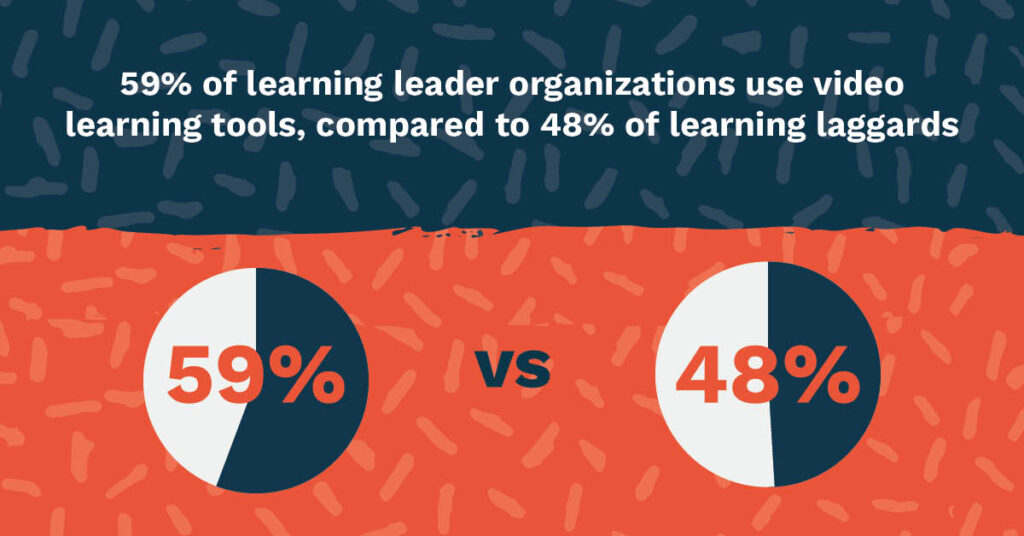
The Most Common (And Uncommon) Learning Technologies Organizations Are Using
It’s great to think about the future—but what kind of learning technologies are organizations using in the here and now? Here’s the rundown:
- 72% of organizations use a learning management system (LMS)
- 64% of organizations use virtual instructor-led training (VILT) or webinars
- 52% of organizations use eLearning platforms like Udemy, Coursera, and LinkedIn Learning
- 52% of organizations use a video learning tool or tools
- 27% of organizations use a microlearning tool or tools
- 24% of organizations use a mobile learning tool or tools
- 24% of organizations use a learning content management system (LCMS)
- 17% of organizations use a social learning tool or tools
- 13% of organizations use a learning experience platform (LXP)
- 11% of organizations use gamification-related tools
- 9% of organizations use a sales enablement platform (SEP)
- 6% of organizations use augmented or virtual reality (AR/VR) training technology
Comparing Top Technologies for Learning Leaders and Learning Laggards
When you look at the best-performing organizations for learning, it’s clear that—across the board—they make more use of learning technologies than their lower-performing counterparts. Let’s break it down:
- 78% of learning leader organizations use a learning management system (LMS), compared to 68% of learning laggards
- 59% of learning leader organizations use video learning tools, compared to 48% of learning laggards
- 60% of learning leader organizations use eLearning platforms like LinkedIn Learning, compared to 46% of learning laggards
- 33% of learning leader organizations use microlearning tools, compared to just 22% of learning laggards
- 29% of learning leader organizations use a learning content management system (LCMS), compared to 16% of learning laggards
- 28% of learning leaders use social learning tools, compared to just 11% of learning laggards
- 25% of learning leader organizations use mobile learning tools, compared to 21% of learning laggards
- 18% of learning leader organizations use gamification-related tools, compared to 6% of learning laggards
- 15% of learning leader organizations use sales enablement platforms (SEPs), compared to 3% of learning laggards
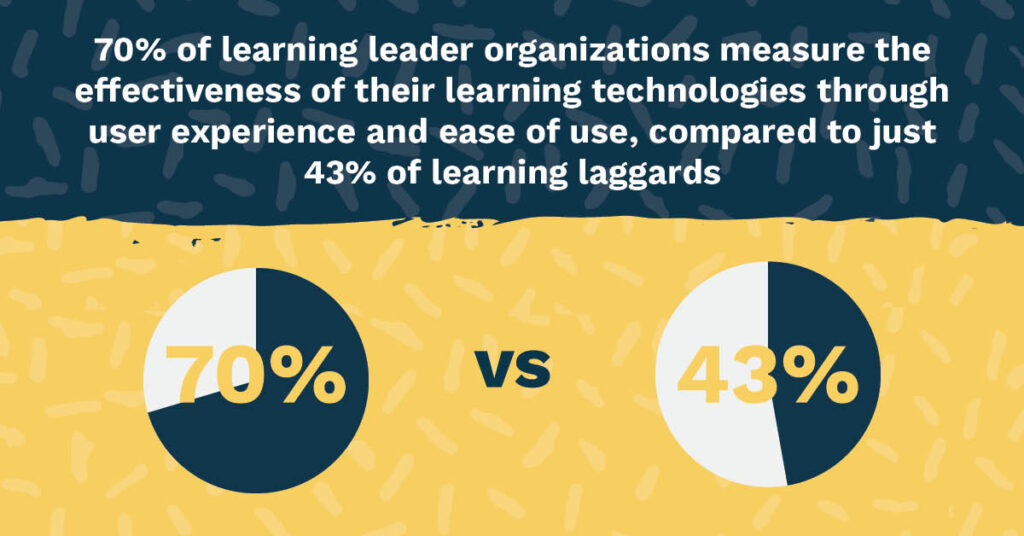
Here’s How Organizations Evaluate the Effectiveness of Their Employee Learning Technologies
How can you tell whether or not your learning technologies are having the desired effect? For many organizations, that depends on the outcomes you’re looking for and the way you want those outcomes to come about—and that diversity of perspectives is reflected in the variety of methods named by our respondents. Here’s the lowdown:
- 57% of organizations gauge the effectiveness of their employee learning technologies by assessing user experience and ease of use
- 47% of organizations gauge the effectiveness of their employee learning technologies by looking at content quality and its relevance to employee needs
- 44% of organizations gauge the effectiveness of their employee learning technologies via data analytics and reporting capabilities
- 44% of organizations gauge the effectiveness of their employee learning technologies through usage rates
- 36% of organizations gauge the effectiveness of their employee learning technologies by assessing their platform’s flexibility and customization capabilities
- 32% of organizations gauge the effectiveness of their employee learning technologies by looking at cost and return on investment (ROI)
- 32% of organizations gauge the effectiveness of their employee learning technologies by assessing their technology’s capacity to integrate with existing systems and processes
- 25% of organizations gauge the effectiveness of their employee learning technologies by taking technical support and maintenance into consideration
- 23% of organizations gauge the effectiveness of their employee learning technologies by looking at security and privacy features
- 20% of organizations gauge the effectiveness of their employee learning technologies by way of their compliance with accessibility standards like Section 508 and WCAG
- 16% of organizations don’t evaluate the effectiveness of their learning technologies
How Do Learning Leaders Evaluate Their L&D Tech Effectiveness?
There are some sizable disparities between learning leaders and learning laggards when it comes to gauging the impact of their learning tech. Here’s what those disparities look like:
- 70% of learning leader organizations evaluate the effectiveness of their learning technologies through user experience and ease of use, compared to just 43% of learning laggards
- 57% of learning leader organizations evaluate the effectiveness of their learning technologies through content quality and relevance to employee needs, compared to just 35% of learning laggards
- 57% of learning leader organizations evaluate the effectiveness of their learning technologies by looking at data analytics and reporting capabilities, compared to just 32% of learning laggards
- 51% of learning leader organizations evaluate the effectiveness of their learning technologies through the customization and flexibility of the platform, compared to 19% of learning laggards
- 42% of learning leader organizations evaluate the effectiveness of their learning technologies through cost and return on investment, compared to 23% of learning laggards
- 38% of learning leader organizations evaluate the effectiveness of their learning technologies by looking at their capacity to integrate with existing systems and processes, compared to 25% of learning laggards
- 32% of learning leader organizations evaluate the effectiveness of their learning technologies by taking technical support and maintenance into consideration, compared to 88. 15% of learning laggards
- 32% of learning leader organizations evaluate the effectiveness of their learning technologies by looking at security and privacy features, compared to 12% of learning laggards
- 30% of learning leader organizations evaluate the effectiveness of their learning technologies by way of their compliance with accessibility standards like Section 508 and WCAG, compared to just 9% of learning laggards
What Are the Common Weaknesses Plaguing Today’s Learning Systems?
Learning systems aren’t all created equal. Capabilities can vary drastically—and it’s also easy for entrenched systems to persist beyond their sell-by dates. Here are some of the common drawbacks and weak points across today’s systems, identified by the people who use them:
- 46% of L&D professionals report that their organization’s learning system suffers from limited collaboration functionality
- 39% of L&D professionals report that their organization’s learning system suffers from a lack of personalization capabilities, like the ability to tailor learning to the specific needs of individual employees
- 35% of L&D professionals report that their organization’s learning system suffers from a poor ability to integrate with other systems
- 28% of L&D professionals report that their organization’s learning system isn’t sufficiently customizable
- 24% of L&D professionals report that their organization’s learning system isn’t mobile-friendly
- 23% of L&D professionals report that their organization’s learning system suffers from an outdated interface
- 16% of L&D professionals report that their organization’s learning system isn’t easily scalable
- 14% of L&D professionals report that their organization’s learning system suffers from a lack of compliance features
- 14% of L&D professionals report that their organization’s learning system suffers from performance bugs
- 12% of L&D professionals report that their organization’s learning system isn’t cloud-based
- 7% of L&D professionals report that their organization’s learning system suffers from slow load speeds
- 6% of L&D professionals report that their organization’s learning system suffers from weaknesses not described above
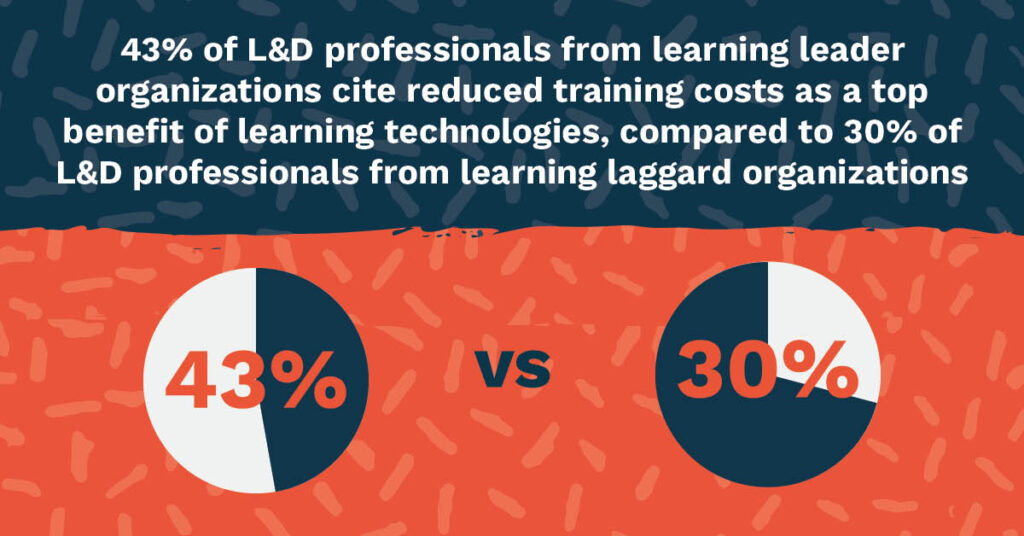
Ranked: The Top Benefits of Using Learning Technologies
While L&D professionals may be quick to spot weaknesses in their learning technologies, that doesn’t mean the benefits aren’t felt. From progress reports to increased productivity, learning tech is doing plenty right—and we’ve got the breakdown:
- 53% of L&D professionals name better tracking and reporting of employee progress and completion as a top benefit of using learning technologies
- 50% of L&D professionals name increased employee flexibility in choosing when and where they learn as a top benefit of using learning technologies
- 41% of L&D professionals name improved training for remote employees as a top benefit of using learning technologies
- 37% of L&D professionals name reduced training costs as a top benefit of using learning technologies
- 29% of L&D professionals name increased employee engagement and satisfaction as a top benefit of using learning technologies
- 28% of L&D professionals name increased productivity and efficiency as a top benefit of using learning technologies
- 27% of L&D professionals name an increased ability to customize training to meet specific employee needs as a top benefit of using learning technologies
- 26% of L&D professionals name improved knowledge retention and application as a top benefit of using learning technologies
- 25% of L&D professionals name improved accuracy and consistency of training as a top benefit of using learning technologies
- 19% of L&D professionals name improved communication and collaboration among employees as a top benefit of using learning technologies
- 18% of L&D professionals name reduced time-to-competency for new hires as a top benefit of using learning technologies
RELATED READING | ‘Learning Analytics: 4 Essential Metrics and Strategies for L&D Success’
Top Benefits of Learning Technologies for Learning Leader Organizations
A number of learning leaders are leveraging their technology more effectively than their laggard counterparts. Consequently, they’re seeing reduced costs and increased flexibility. Here’s how the numbers look:
- 57% of L&D professionals from learning leader organizations cite increased employee flexibility in terms of when and where they learn as a top benefit of learning technologies, compared to 41% of L&D professionals from learning laggard organizations
- 43% of L&D professionals from learning leader organizations cite reduced training costs as a top benefit of learning technologies, compared to 30% of L&D professionals from learning laggard organizations
- 27% of L&D professionals from learning leader organizations cite reduced time to competency for new hires as a top benefit of learning technologies, compared to just 13% of L&D professionals from learning laggard organizations
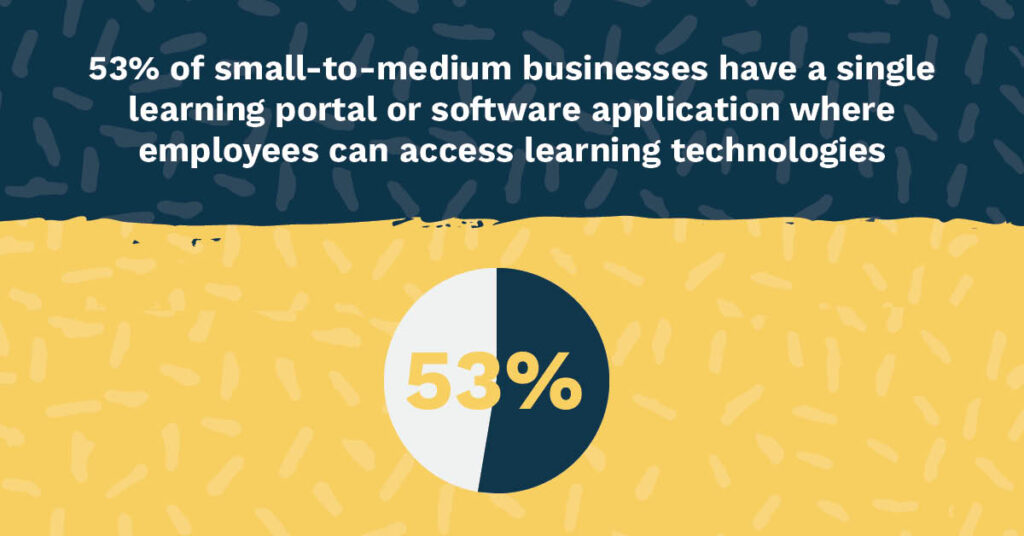
Do Organizations Have a Dedicated Space to Access Learning Technologies?
Almost every L&D professional cited in our report was able to claim that their organization has one or more portals through which employees can access their learning tech. Here are the figures:
- In 47% of organizations, employees have a single portal or software application (like an LMS) where they can go to access learning technologies
- In 40% of organizations, employees have several places from which they can access learning technologies
- 2% of organizations don’t have a place where employees can go to access learning technologies, but they’re in the process of building one
3% of organizations don’t have a place where employees can go to access learning technologies, but they’re planning one
- 3% of organizations don’t have a place where employees can go to access learning technologies, but they want to create one
- 5% of organizations don’t have a place where employees can go to access learning technologies, and they have no desire to create one
Here’s How Organization Size Impacts the Availability of Learning Spaces
Zooming in on those organizations which have a single learning portal, it’s clear that there’s a disparity between small-to-medium and larger organizations. Take a look:
- 53% of small-to-medium businesses have a single learning portal or software application where employees can access learning technologies
- 36% of large organizations have a single learning portal or software application where employees can access learning technologies
How Do Employees Feel About Learning Tech Capabilities and Ease of Use?
As part of the report, respondents were asked how they felt about a range of statements on employee attitudes toward devices, integration, and general satisfaction with their learning technologies. Here’s what they had to say:
The Availability of Learning Tech on Different Devices
While over half of the respondents were confident that employees can access learning technologies on the device of their choosing, including mobile devices, that still leaves a fair proportion who were less confident. Take a look:
- 7% of L&D professionals strongly disagree that their organizations’ learning technologies are available on employees’ devices of choice
- 17% of L&D professionals disagree that their organizations’ learning technologies are available on employees’ devices of choice
- 16% of L&D professionals neither agree nor disagree that their organizations’ learning technologies are available on employees’ devices of choice
- 46% of L&D professionals agree that their organizations’ learning technologies are available on employees’ devices of choice
- 16% of L&D professionals strongly agree that their organizations’ learning technologies are available on employees’ devices of choice
How Well Is Learning Technology Integrated With Other Major Systems?
Learning technologies can be part of a wider infrastructure—but how well do these different technologies integrate with one another? Let’s find out:
- 8% of L&D professionals strongly disagree that their organizations’ learning technologies are integrated with other major systems (such as an ERP or HRMS)
- 29% of L&D professionals disagree that their organizations’ learning technologies are integrated with other major systems (such as an ERP or HRMS)
- 20% of L&D professionals neither agree nor disagree that their organizations’ learning technologies are integrated with other major systems (such as an ERP or HRMS)
- 34% of L&D professionals agree that their organizations’ learning technologies are integrated with other major systems (such as an ERP or HRMS)
- 11% of L&D professionals strongly agree that their organizations’ learning technologies are integrated with other major systems (such as an ERP or HRMS)
Are Learning Technologies Well Integrated With One Another?
For over 60% of respondents, learning technologies don’t necessarily gel with one another. This may point to a need for all-in-one solutions that come equipped with a suite of technologies to suit every occasion. Here’s the breakdown:
- 5% of L&D professionals strongly disagree that their organizations’ learning technologies are well integrated with one another
- 24% of L&D professionals disagree that their organizations’ learning technologies are well integrated with one another
- 34% of L&D professionals neither agree nor disagree that their organizations’ learning technologies are well integrated with one another
- Just 28% of L&D professionals agree that their organizations’ learning technologies are well integrated with one another
- Just 8% of L&D professionals strongly agree that their organizations’ learning technologies are well integrated with one another
Are HR and L&D Functions Able to Effectively Use Their Organizations’ Learning Technologies?
Ease of use is an essential characteristic of any good piece of learning technology—but how common is it? Let’s find out:
- No L&D professionals strongly disagree that their organizations’ HR and/or L&D departments are able to use their learning technologies effectively
- 10% of L&D professionals disagree that their organizations’ HR and/or L&D departments are able to use their learning technologies effectively
- 19% of L&D professionals neither agree nor disagree that their organizations’ HR and/or L&D departments are able to use their learning technologies effectively
- 58% of L&D professionals agree that their organizations’ HR and/or L&D departments are able to use their learning technologies effectively
- 13% of L&D professionals strongly agree that their organizations’ HR and/or L&D departments are able to use their learning technologies effectively
Can Employees Use Their Organizations’ Learning Technologies Effectively?
If ease of use matters for people who live and breathe learning tech, that counts for double among the employees who need to work with potentially unfamiliar tools and solutions. Luckily, the majority of organizations report that employees can use their learning tech without too much trouble:
- 3% of L&D professionals strongly disagree that employees are able to use their organizations’ learning technologies effectively
- 16% of L&D professionals disagree that employees are able to use their organizations’ learning technologies effectively
- 20% of L&D professionals neither agree nor disagree that employees are able to use their organizations’ learning technologies effectively
- 54% of L&D professionals agree that employees are able to use their organizations’ learning technologies effectively
- 8% of L&D professionals strongly agree that employees are able to use their organizations’ learning technologies effectively
Are Employees Satisfied With Their Organizations’ Learning Technologies?
Employees might tend to be able to use their learning technologies, but are they satisfied with the solutions they’re given? This was a less clear-cut response, with over half of respondents expressing uncertainty—or outright confirming that employees aren’t satisfied. Here’s the spread:
- 5% of L&D professionals strongly disagree that employees are satisfied with their organizations’ learning technologies
- 20% of L&D professionals disagree that employees are satisfied with their organizations’ learning technologies
- 35% of L&D professionals neither agree nor disagree that employees are satisfied with their organizations’ learning technologies
- 32% of L&D professionals agree that employees are satisfied with their organizations’ learning technologies
- 8% of L&D professionals strongly agree that employees are satisfied with their organizations’ learning technologies
How Does the Data Change When You Compare Learning Leaders to Learning Laggards?
Across the above five topics, some pretty major differences between learning leaders and learning laggards started to emerge:
- 87% of L&D professionals from learning leader organizations agree that their HR or L&D functions are able to effectively use their organizations’ learning technologies, compared to 52% of L&D professionals from learning laggard organizations who said the same
- 84% of L&D professionals from learning leader organizations agree that employees are able to effectively use their organizations’ learning technologies, compared to just 38% of L&D professionals from learning laggard organizations who said the same
- 82% of L&D professionals from learning leader organizations agree that their learning technologies are available on employees’ devices of choice, compared to just 37% of L&D professionals from learning laggard organizations who said the same
- 69% of L&D professionals from learning leader organizations agree that employees are satisfied with their learning technologies, compared to just 37% of L&D professionals from learning laggard organizations who said the same
- 49% of L&D professionals from learning leader organizations agree that their learning technologies are integrated with major systems like an ERP or HRMS, compared to 37% of L&D professionals from learning laggard organizations who said the same
- 47% of L&D professionals from learning leader organizations agree that their learning technologies are well integrated with one another, compared to just 25% of L&D professionals from learning laggard organizations who said the same
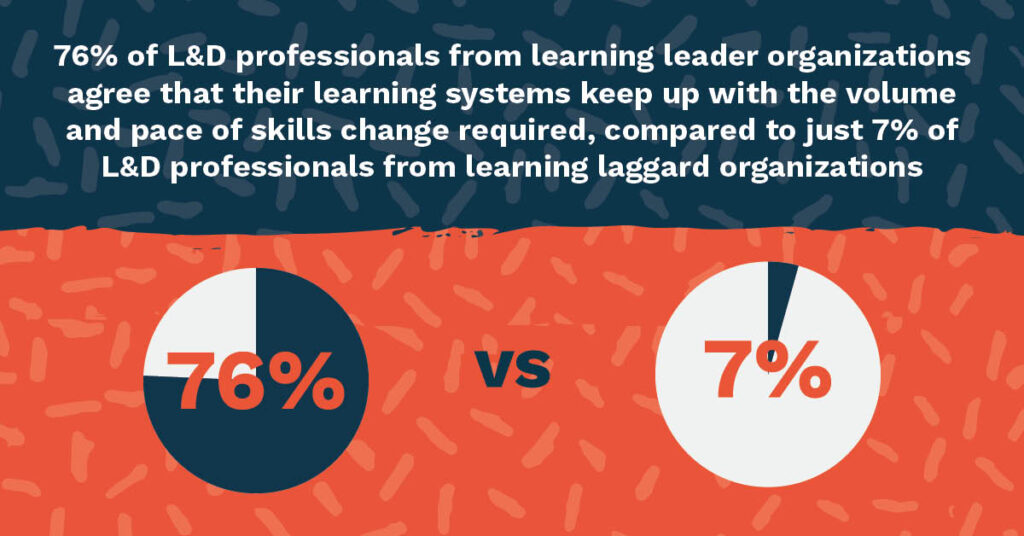
How Do L&D Professionals Feel About the Quality of Learning and Development in Their Organizations?
We’ve covered how L&D professionals feel about the functionality of their learning technologies—but how does the technology impact the quality of learning in different organizations? Let’s find out.
Are Learning Systems Keeping Up With Changing Skills Needs?
Skills needs are constantly changing, and the best learning technologies will be able to suggest up-to-date skills for various job roles—but are organizations using technologies that boast this kind of feature? The data suggests that many don’t. Here’s the rundown:
- Just 2% of L&D professionals strongly disagree that their organizations’ learning systems keep up with the volume and pace of skills change required
- 24% of L&D professionals disagree that their organizations’ learning systems keep up with the volume and pace of skills change required
- 31% of L&D professionals neither agree nor disagree that their organizations’ learning systems keep up with the volume and pace of skills change required
- 33% of L&D professionals agree that their organizations’ learning systems keep up with the volume and pace of skills change required
- 10% of L&D professionals agree that their organizations’ learning systems keep up with the volume and pace of skills change required
MORE SKILLS INSIGHTS | ‘Want to Address Your Skills Gaps? Here’s How AI-Assisted Skills Assessments Can Help’
Are Learning Systems Preparing Employees for Their Jobs?
Employees don’t learn just for learning’s sake: L&D is there to ensure your people have the skills to match their roles—but are technologies like learning management systems leaving workers prepared for their jobs? Here’s what you need to know:
- 3% of L&D professionals strongly disagree that employees feel their organizations’ learning systems prepare them for their jobs
- 19% of L&D professionals disagree that employees feel their organizations’ learning systems prepare them for their jobs
- 37% of L&D professionals neither agree nor disagree that employees feel their organizations’ learning systems prepare them for their jobs
- 33% of L&D professionals agree that employees feel their organizations’ learning systems prepare them for their jobs
- 8% of L&D professionals strongly agree that employees feel their organizations’ learning systems prepare them for their jobs
Are Organizations Developing Strong Cultures of Learning?
Learning technologies exist within, and feed into, cultural learning practices at any organization. But are those cultures present and correct for our respondents? Let’s find out:
- 4% of L&D professionals strongly disagree that a strong culture of learning has been established at their organizations
- 22% of L&D professionals disagree that a strong culture of learning has been established at their organizations
- 31% of L&D professionals neither agree nor disagree that a strong culture of learning has been established at their organizations
- 29% of L&D professionals agree that a strong culture of learning has been established at their organizations
- 14% of L&D professionals strongly agree that a strong culture of learning has been established at their organizations
What’s the Overall Impression of L&D Quality Among Learning Professionals?
When asked how they felt about the overall quality of learning in their organizations, here’s what our L&D professionals said:
- 4% of L&D professionals strongly disagree that, overall, L&D in their organizations is excellent
- 13% of L&D professionals disagree that, overall, L&D in their organizations is excellent
- 32% of L&D professionals neither agree nor disagree that, overall, L&D in their organizations is excellent
- 39% of L&D professionals agree that, overall, L&D in their organizations is excellent
- 12% of L&D professionals strongly agree that, overall, L&D in their organizations is excellent
Here’s How L&D Quality Differs Based on Organization Size
Once again, organization size has a part to play regarding key aspects of L&D quality. Let’s take a look:
- 59% of L&D professionals in small-to-medium organizations agree that the quality of their organization’s L&D is excellent, compared to 46% of L&D professionals in large organizations
- 46% of L&D professionals in small-to-medium organizations agree that their learning systems keep up with the volume and pace of skills change required, compared to 34% of L&D professionals in large organizations
Here’s How L&D Quality Differs Between Leaders and Laggards
It’s no surprise that learning leaders and learning laggards have very different levels of quality attached to their learning efforts. Here’s the lowdown:
- 79% of L&D professionals from learning leader organizations agree that there’s a top-notch culture of learning where they work, compared to just 8% of L&D professionals from learning laggard organizations
- 76% of L&D professionals from learning leader organizations agree that their learning systems keep up with the volume and pace of skills change required, compared to just 7% of L&D professionals from learning laggard organizations
- 75% of L&D professionals from learning leader organizations agree that employees feel their learning systems prepare them for their jobs, compared to just 7% of L&D professionals from learning laggard organizations
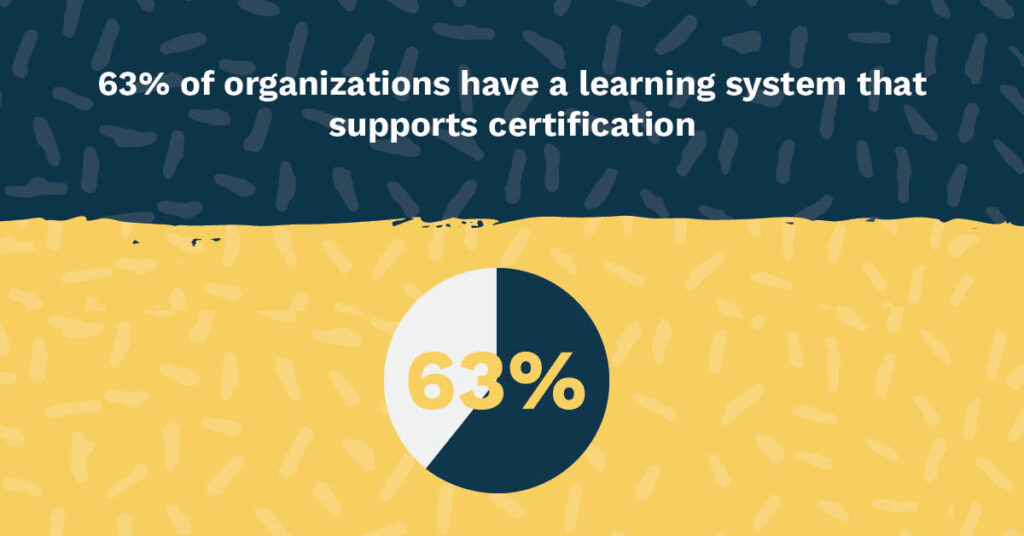
The Most Important Learning System Capabilities Ranked
What features and capabilities of learning systems matter most to L&D professionals? Let’s take a look:
- 71% of L&D professionals cite learning engagement as one of their organizations’ most important learning system-related capabilities
- 64% of L&D professionals cite access to on-demand training and quick support as one of their organizations’ most important learning system-related capabilities
- 48% of L&D professionals cite an intuitive user interface as one of their organizations’ most important learning system-related capabilities
- 40% of L&D professionals cite a wide breadth of offerings as one of their organizations’ most important learning system-related capabilities
- 38% of L&D professionals cite customizable reporting as one of their organizations’ most important learning system-related capabilities
- 34% of L&D professionals cite enterprise system integration (with systems like a CRM/ERP/HRMS/HCM) as one of their organizations’ most important learning system-related capabilities
- 32% of L&D professionals cite collaboration tools as one of their organizations’ most important learning system-related capabilities
- 27% of L&D professionals cite multiplatform accessibility as one of their organizations’ most important learning system-related capabilities
- 23% of L&D professionals cite customer support as one of their organizations’ most important learning system-related capabilities
- 19% of L&D professionals cite data migration as one of their organizations’ most important learning system-related capabilities
- 13% of L&D professionals cite brand integration as one of their organizations’ most important learning system-related capabilities
What Capabilities Do Learning Systems Tend to Have?
It’s one thing to know what capabilities are seen as the most important—but a robust learning management system or similar solution will have more than one trick up its sleeve. Here’s a fuller picture:
- 83% of organizations have learning systems with online course capabilities
- 62% of organizations have learning systems with reports that track progress
- 62% of organizations have learning systems with learner assessments and tests
- 56% of organizations have learning systems with course management capabilities
- 51% of organizations have learning systems with user dashboards
- 50% of organizations have learning systems with mobile learning features
- 47% of organizations have learning systems with customizable learning paths or journeys
- 44% of organizations have learning systems with targeted training for career development
- 43% of organizations have learning systems with SCORM capabilities
- 40% of organizations have learning systems with microlearning capabilities
- 37% of organizations have learning systems with personalized learning capabilities
- 29% of organizations have learning systems with features that track and document current skill levels
- 29% of organizations have learning systems with the ability to customize to meet learner needs
- 29% of organizations have learning systems with integrated virtual live classroom training capabilities
The Top Performance-Related Features Supported by Learning Systems
Learning systems aren’t always limited to learning. Some will have a deeply integrated performance management system like Bridge’s, while others will offer a handful of performance features. So, what do those features look like? Let’s find out:
- 63% of organizations have a learning system that supports certification
- 38% of organizations have a learning system that supports individual development plans
- 37% of organizations have a learning system that supports employee performance assessments
- 19% of organizations have a learning system that supports gamification
- 18% of organizations have a learning system that supports learning impact
- 16% of organizations don’t report that their learning systems support any of the capabilities mentioned above
MORE FROM THE BLOG | ‘Are Perceptions of Performance Management Getting More Negative?’
Learning Leaders Favor Performance Features—Here’s the Data
Our data suggests that learning leader organizations are more likely to embrace performance-related features. Take a look:
- 51% of learning leaders have learning systems that support individual development plans, compared to 24% of learning laggards
- 49% of learning leaders have learning systems that support employee performance assessments, compared to 24% of learning laggards
- 34% of learning leaders have learning systems with learning impact-related features—whereas none of the learning laggards surveyed could say the same
- Only 3% of learning leaders said their learning systems didn’t support any of the performance features named in the survey, compared to a significant 31% of learning laggards
What Collaboration Features Are Supported by Today’s Learning Systems?
You might be able to do digital learning from anywhere—but that doesn’t mean you have to do it alone. While over a third of respondents didn’t lay claim to any of the collaborative features mentioned in the survey, here’s how the full spread of responses played out:
- 33% of organizations have learning systems with a group chat functionality
- 31% of organizations have learning systems with web conferencing features
- 31% of organizations have learning systems with webcast capabilities
- 24% of organizations have learning systems that support real-time discussions among geographically dispersed people (like instant messaging)
- 18% of organizations have learning systems with coaching features
- 17% of organizations have learning systems with virtual or augmented reality features
- 15% of organizations have learning systems that support enterprise social networks
- 37% of organizations have learning systems that don’t support any of the features mentioned above
Learning Leaders Are Ahead on Collaborative Learning Features
Unsurprisingly, learning leaders are leading the pack when it comes to collaboration:
- 46% of learning leader organizations have learning systems that support a group chat functionality, compared to 15% of learning laggards
- 35% of learning leader organizations have learning systems that support real-time discussions among geographically dispersed people, compared to just 12% of learning laggards
- 28% of learning leader organizations have learning systems that support coaching features, compared to just 8% of learning laggards
- 23% of learning leader organizations don’t have learning systems that support the collaborative learning features listed in the survey—compared to an enormous 52% of learning laggards
What Are the Most Common Creation And Curation Capabilities Supported by Learning Systems?
A good learning management system is so much more than a repository of learning materials—it can also be a good way to create them, whether that’s through basic content creation tools or advanced course authoring capabilities. So, what can our respondents create? Let’s find out:
- 60% of organizations have learning systems that support the creation of eLearning courses
- 47% of organizations have learning systems that support the creation of blended learning
- 45% of organizations have learning systems that support content curation
- 41% of organizations have learning systems that support video creation
- 26% of organizations have learning systems that support content aggregation
- 17% of organizations have learning systems that support the creation of simulations
- 11% of organizations have learning systems that support the creation of games
- 17% of organizations have learning systems that don’t support any of the capabilities named above
Learning Leaders Favor Creation and Curation Capabilities
As with many of our statistics around learning tech capabilities, learning leaders are much more likely to have systems that offer a variety of content creation and curation options. For example:
- 69% of learning leader organizations have a learning system that supports the creation of eLearning courses, compared to 49% of learning laggards
- 56% of learning leader organizations have a learning system that supports the creation of blended learning, compared to 36% of learning laggards
- 36% of learning leader organizations have a learning system that supports content aggregation, compared to 15% of learning laggards
- 30% of learning leader organizations have a learning system that supports the creation of simulations, compared to 4% of learning laggards
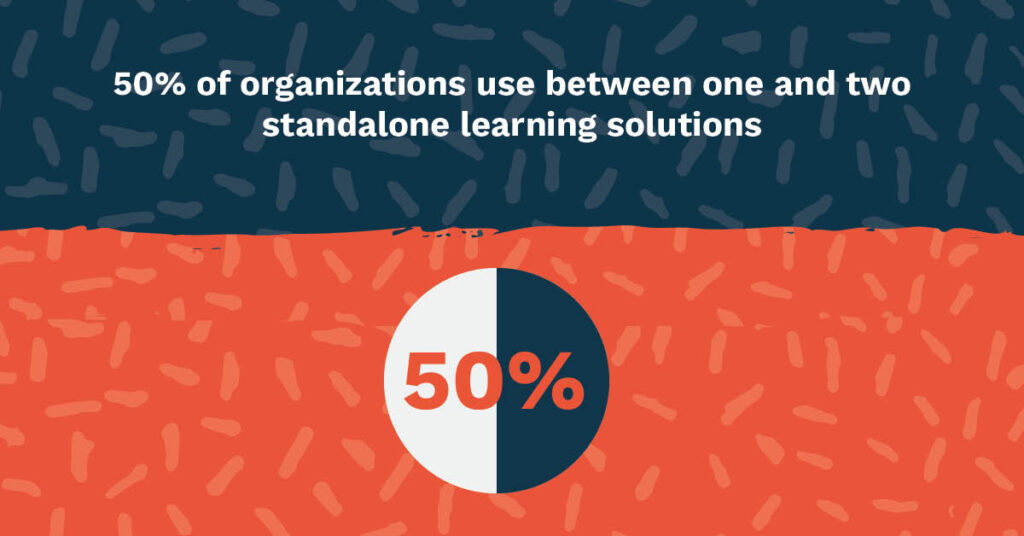
The Popularity of Standalone Learning Solutions
The vast majority of organizations use a standalone learning solution—and a significant proportion have several on their hands. Here’s how the spread of solutions plays out:
- 8% of organizations don’t have a standalone learning solution
- 50% of organizations use between one and two standalone learning solutions
- 29% of organizations use between three and four standalone learning solutions
- 9% of organizations use between five and six standalone learning solutions
- 2% of organizations use between seven and eight learning solutions
- 4% of organizations use nine or more standalone learning solutions
How Many Organizations Use Learning Technology Within Larger Systems?
It’s not uncommon for organizations to consolidate their learning systems into a bigger solution—for example by using an LMS that’s built into a larger HRIS. But this is far from a universal approach: over a third of respondents don’t do this, perhaps because they’re aware of the limitations that often accompany a built-in LMS. Here’s how the numbers look:
- 35% of organizations don’t use learning technology applications that are modules of a larger system
- 50% of organizations use one or two learning technology applications that are modules of a larger system
- 9% of organizations use three or four learning technology applications that are modules of a larger system
- 2% of organizations use five or six learning technology applications that are modules of a larger system
- 1% of organizations use seven or eight learning technology applications that are modules of a larger system
- 4% of organizations use nine or more learning technology applications that are modules of a larger system
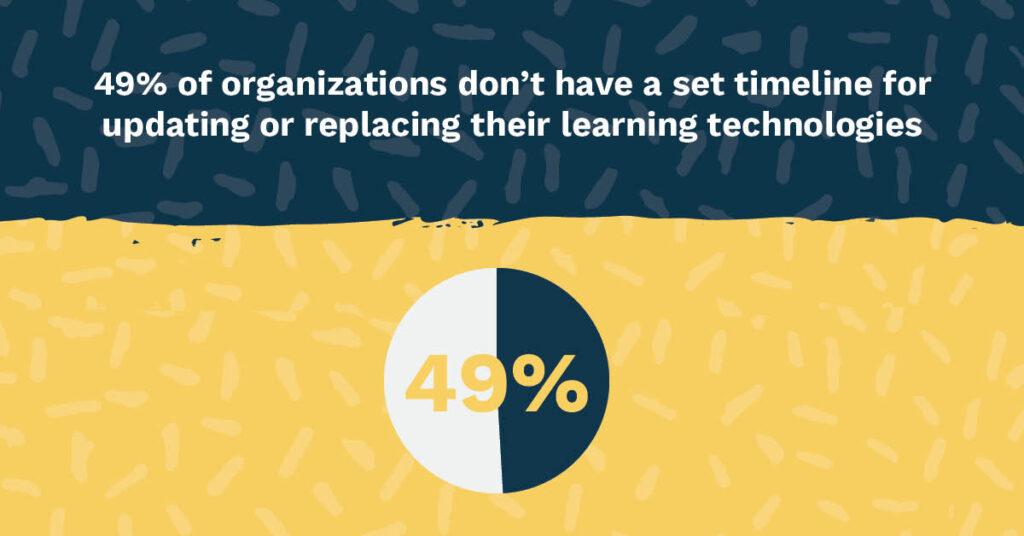
Here’s How Often Organizations Tend to Update or Replace Their Main Learning Technologies
As growing organizations scale, or as long-standing entities re-evaluate legacy systems, there’s always scope for updating (or outright replacing) learning systems—but do organizations have a structured timescale for achieving that? Let’s find out:
- 7% of organizations replace or update their primary learning technologies at least every year
- 10% of organizations replace or update their primary learning technologies every one to two years
- 23% of organizations replace or update their primary learning technologies every three to five years
- 8% of organizations replace or update their primary learning technologies every six to ten years
- 2% of organizations replace or update their primary learning technologies less than once per ten years
- 49% of organizations don’t have a set timeline for updating or replacing their learning technologies
Get the Insights Behind the Stats With Our Full Report
The full, Bridge-sponsored report, “The Future of Learning Technologies 2023,” is brimming with key takeaways and in-depth analysis. Check out the report today, and don’t hesitate to get in touch if you’re looking to ensure that your learning infrastructure is powered by the best and brightest solutions in the space.




